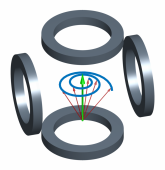BMBF-MPI²: Model-based parameter identification in magnetic particle imaging
| Working Group: | WG Industrial Mathematics |
| Leadership: |
Prof. Dr. Dr. h.c. Peter Maaß ((0421) 218-63801, E-Mail: pmaass@math.uni-bremen.de )
Dr. Tobias Kluth |
| Processor: |
Christine Bathke
Sabine Eifeld (E-Mail: eifeld@math.uni-bremen.de ) Janna Flötotto Hannes Albers ((0421) 218-63818, E-Mail: halbers@uni-bremen.de) Delf Lachmund |
| Funding: | BMBF |
| Project partner: |
Prof. Dr. Hans-Georg Stark, Hochschule Aschaffenburg Prof. Dr. Thomas Schuster, Universität des Saarlandes Prof. Dr. Ing. Tobias Knopp, Universitätsklinikum Hamburg-Eppendorf |
| Time period: | 01.12.2016 - 30.11.2019 |
| Website: | http://www.math.uni-bremen.de/zetem/bmbf-mpi2 |

Ever since x-ray tomography has been discovered in the 1970s, imaging methods continue to revolutionize medical diagnostics. Today, there exists a variety of tomographic methods, that offer different advantages and disadvantages, and are therefore used for different tasks. The most important methods are x-ray computed tomography (CT) and magnetic resonance imaging (MRI) for imaging anatomy as well as positron emission tomography (PET) and single photon emission computed tomography (SPECT) for imaging certain processes in the patient.
In the beginning of this century a new imaging method called Magnetic Particle Imaging (MPI) has been developed. It is based on tracing iron oxide nanoparticles through the blood vessels of the human body. This method does not need any harmful radiation, is highly sensitive to even small amounts of tracer and offers a high temporal resolution.
This makes MPI almost predestined for diagnosing cardiovascular diseases. Another important application can be found in the catheter labratory, where MPI could enable doctors to navigate through vessel trees in three-dimensional space using a specifically marked catheter.
In the collobarative research project MPI² model-based methods and their efficient realizations in algorithms are investigated since the beginning of 2017. Besides the university partners from the Aschaffenburg University of Applied Sciences, Medical Center Hamburg-Eppendorf (UKE) and Saarland University, industrial partners complement the consortium. SCiLS, a branch of Bruker Daltonik GmbH, and the Center for Radiology and Endoscopy of the UKE Hamburg-Eppendorf, as well as Bruker BioSpin, the manufacturer of the first commercially distributed MPI device, support the joint project.
The ZeTeM (Prof. Dr. Peter Maaß, Dr. Tobias Kluth) coordinates the collaboration and manages the subproject on image reconstruction. For determining the particle concentration in MPI, the magnetization property of metallic nanoparticles plays a crucial role. Outside of the object to be examined a static magnetic field is applied that brings the magnetization of the particles inside the object into saturation almost everywhere. Only along a certain trajectory of field-free points, there are small areas where the strength of the magnetic field allows measurable changes in the magnetization of the nanoparticles. A superposition with a second magnetic field, varying dynamically, moves the field-free point along the trajectory and also changes the magnetization of particles in the vincinity of this point, which can be detected as a change in voltage.
In the development of new reconstruction methods for MPI a primary focus is to compensate for the high model uncertainties present. So far there is no model with sufficient accuracy available. Therefore, the system matrix describing the relation between particle concentration and measured voltage needs to be measured. The aim is to shorten this time consuming calibration process considerably or to remove it completely. To this end more detailed models that incorporate the particle relaxation are investigated. For the image reconstruction the total least squares approach is studied to help in overcoming the model errors and therefore getting rid of the calibration process. The total least squares approach does not only reconstruct the particle concentration but also unknown model parameters in addition. That way the original linear inverse problem becomes a nonlinear problem, that has to be analyzed and solved.
The work in this project has started with the kick-off meeting in February 2017. In this meeting not only the research partners but also representatives of the industrial partner Bruker BioSpin and of the promoter DESY came together.
Publications
- T. Kluth, P. Maaß.
Model uncertainty in magnetic particle imaging: Nonlinear problem formulation and model-based sparse reconstruction.
International Journal on Magnetic Particle Imaging, Article ID 1707004 3(2), 10 pages, 2017.

